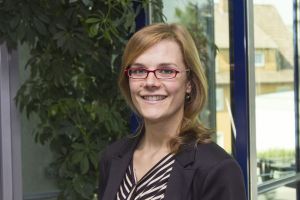For her path-breaking work on radio transmission technologies, Dr. Friederike Brendel is granted the 2013 Bertha Benz Prize. The young engineer wrote her Ph. D. thesis on glass fiber-based high-frequency transmission systems in the millimeter wave range at Karlsruhe Institute of Technology (KIT). Based on her results, the data rate transmitted can be multiplied and rapid low-cost ports can be developed. Every year, this prize of the Daimler and Benz Foundation goes to an excellent Ph. D. thesis written by a young female engineer. The prize is endowed with EUR 10,000. It will be presented today, Thursday, July 04, at the Bertha Benz Lecture in Heidelberg.
The Ph. D. thesis “Millimeter Wave Radio-over-fiber Links Based on Mode-locked Laser Diodes” of Friederike Brendel spans several disciplines. She defended her thesis on January 23 this year at KIT’s Institut für Hochfrequenztechnik und Elektronik. Her work was embedded in a German-French Ph. D. project with the Institut Polytechnique de Grenoble. Today, the engineer works as a product manager with HBC-radiomatic GmbH, a manufacturer of radio systems, at Crailsheim. The Bertha Benz Prize of the Daimler and Benz Foundation is to acknowledge the path-breaking contribution of young female researchers to engineering sciences. The prize is named after Bertha Benz, whose technical expertise and entrepreneurial spirit decisively contributed to the public acceptance of the automobile.
Friederike Brendel’s Ph. D. thesis covers the transmission of radio signals in the millimeter wave range via glass fibers. Her research was motivated by constantly increasing requirements on communication in terms of maximum comfort and minimum impacts of radio signals on man’s living environment. “My scientific studies were aimed at reaching rapid and stable signal transmission and at increasing the data rate by several factors. On the other hand, it appeared desirable to restrict the radio range, i.e. to single rooms within an apartment,” Brendel explains. The development of inexpensive and rapid ports is now considered feasible by the young engineer.
Brendel’s work focuses on double signal conversion. Originally electric millimeter wave signals are converted into light information that is transmitted by optical fibers. At the output, this light information is made available in the form of analog millimeter waves again. For this purpose, the complete system has to be analyzed first. Then, the individual components, such as laser diodes or photodetectors, have to be characterized. The communication or transmission chain also requires the investigation of so-called modulation techniques, i.e. application of the high-frequency signals to be transmitted to the optical carrier signal, as well as studies of propagation effects via glass fibers networks. Stability of the modified and transported signal is of crucial importance.
In his opinion on Friederike Brendel’s Ph. D. thesis, Professor Thomas Zwick, Head of the Institut für Hochfrequenztechnik und Elektronik, writes: “The thesis spans several disciplines and covers classical high-frequency systems technology as well as laser physics, optical communication technology, telecommunications engineering, and areas of control technology. It was the major achievement of Mrs. Brendel to develop a comprehensive understanding of these areas, as the communication system studied by her is influenced by every individual component. The innovative signal stabilization solution developed by her reflects her analytical creativity. The respective patent application was filed in January 2012.”
About the Daimler and Benz Foundation
Stimuli for knowledge – the Daimler and Benz Foundation supports knowledge generation processes by specific stimuli. It concentrates on the support of young scientists, interdisciplinary cooperation projects, and research projects in various scientific disciplines. The present annual funding volume is about 3 million Euros. With assets in the amount of EUR 125 million, the operative foundation is one of the largest science-supporting foundations in Germany.
In close partnership with society, KIT develops solutions for urgent challenges – from climate change, energy transition and sustainable use of natural resources to artificial intelligence, sovereignty and an aging population. As The University in the Helmholtz Association, KIT unites scientific excellence from insight to application-driven research under one roof – and is thus in a unique position to drive this transformation. As a University of Excellence, KIT offers its more than 10,000 employees and 22,800 students outstanding opportunities to shape a sustainable and resilient future. KIT – Science for Impact.

